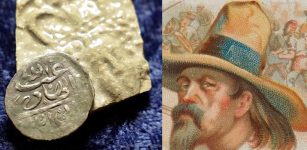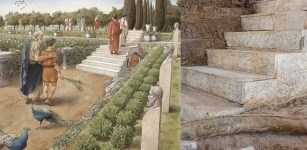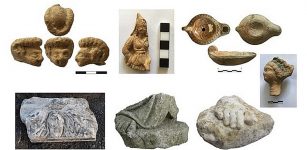Mysterious ‘Las Labradas’ Petroglyphs With Roots In The Pre-Columbian Times Of Mexico
A. Sutherland - AncientPages.com - Sinaloa's rocks covered with a variety of figures are true history rocks, a legacy of mythological traditions with roots in the Pre-columbian times of North America.
Little is known of the Sinaloa people and their early history. However, ancient carvings and legends represent a legacy of these people. Las Labradas petroglyphs' area is a very ancient and sacred site to the coastal Indians of the area.

A large number of beautiful petroglyphs known as 'las labradas' have been found on a beach in the vicinity of Barras de Piaxtla, a small fishing village, north of Mazatlan in the Mexican state of Sinaloa.
Many of the carvings suffered significant damage due to weather and water over the centuries.
Remarkably, natural erosion hasn't been destructive enough to erase all the testimonies left by the ancients for future generations.

It's still quite easy to recognize many anthropomorphic, zoomorphic or geometric forms that represent solar phenomena expressed with lines, dots, ancient spirals, and figures.
In 1949 engineer Gonzalo Ortiz de Zárate arrived in Culiacán. Of Spanish origin, he came to land in Sinaloa to work in Eureka, a construction company that would be in charge, at that time, to build the irrigation canals of the Sanalona dam.
Accidentally, on one of the beaches of the Sinaloan Pacific, he stumbled upon one of his best finds: "more than 300 meters of rocks of volcanic origin piled at the foot of the beach with a huge number of engravings: evocations of the sun through concentric circles, flowers, animals, human figures... total, almost 650 different prints. The beach, already known then as “las labradas”, was in the set of small inlets near the mouth of the Piaxtla river, known as “Barras de Piaxtla,” as wrote Professor Juan González Morfín, Universidad Panamerican, Mexico.
Many cultures left similar carvings around the world and Sinaloa's prehistoric region is one of them. The ancient carvings were left by the groups that belonged to Aztatlán culture, Sinaloa, México, and living along the rivers of Sinaloa.

Perhaps these people also recorded their prehistoric testimonies on other rocks discovered in several places in Sinaloa.
The Aztatlán culture was one of the major cultures that developed during the late pre-Hispanic northwest Mesoamerica (900 to 1350 AD). Only a few archaeological excavations were carried out over the last fifty years in this region. However, there is some evidence that the Aztatlán culture had a significant influence on social changes in northern Mexico and the American Southwest.
In 1942, Manuel Bonilla (1867 - 1957), a scholar and one of few, who described intriguing petroglyphs of Sinaloa, in his book "De Atlatlán a México" (From Atlatlán to Mexico) said that these relics constitute a very important key to the history of prehistoric peoples of Mexico.
Written by – A. Sutherland - AncientPages.com Senior Staff Writer
Copyright © AncientPages.com All rights reserved. This material may not be published, broadcast, rewritten or redistributed in whole or part without the express written permission of AncientPages.com
Expand for referencesMore From Ancient Pages
-
 Lost Knowledge Of Energy And Crystal Technology In Ancient Egypt
Ancient Mysteries | May 17, 2019
Lost Knowledge Of Energy And Crystal Technology In Ancient Egypt
Ancient Mysteries | May 17, 2019 -
 Can This Ancient Coin Solve The Mysterious Disappearance Of Pirate Henry Every?
Archaeology | Apr 1, 2021
Can This Ancient Coin Solve The Mysterious Disappearance Of Pirate Henry Every?
Archaeology | Apr 1, 2021 -
 Lavish Home And Exotic Garden Of Emperor Caligula Discovered In Rome
Archaeology | Nov 19, 2020
Lavish Home And Exotic Garden Of Emperor Caligula Discovered In Rome
Archaeology | Nov 19, 2020 -
 Dearg-Due Frightening Female Demon And Tyrannical Abhartach Of Irish Folklore
Celtic Mythology | Jan 5, 2017
Dearg-Due Frightening Female Demon And Tyrannical Abhartach Of Irish Folklore
Celtic Mythology | Jan 5, 2017 -
 Evidence Of An Unknown Neolithic Society At Oued Beht In North Africa Discovered
Archaeology | Sep 30, 2024
Evidence Of An Unknown Neolithic Society At Oued Beht In North Africa Discovered
Archaeology | Sep 30, 2024 -
 Fire Reveals Notre-Dame De Paris Cathedral Was Historical First In Using Iron Reinforcements In The 12th Century
Archaeology | Mar 17, 2023
Fire Reveals Notre-Dame De Paris Cathedral Was Historical First In Using Iron Reinforcements In The 12th Century
Archaeology | Mar 17, 2023 -
 Indigenous Communities Used The Caribbean Sea As An Aquatic Highway
Archaeology | Jun 23, 2022
Indigenous Communities Used The Caribbean Sea As An Aquatic Highway
Archaeology | Jun 23, 2022 -
 South African Rock Art May Be Inspired By Long-Extinct Species
Archaeology | Sep 19, 2024
South African Rock Art May Be Inspired By Long-Extinct Species
Archaeology | Sep 19, 2024 -
 Neanderthals: How A Carnivore Diet May Have Led To Their Demise
Featured Stories | Nov 7, 2022
Neanderthals: How A Carnivore Diet May Have Led To Their Demise
Featured Stories | Nov 7, 2022 -
 On This Day In History: Famous British Archaeologist And Egyptologist Sir Flinders Petrie Born – On June 3, 1853
News | Jun 3, 2016
On This Day In History: Famous British Archaeologist And Egyptologist Sir Flinders Petrie Born – On June 3, 1853
News | Jun 3, 2016 -
 Will The Oven Bricks Of The Tudor Warship The Mary Rose Be Preserved Before It’s Too Late?
Artifacts | Apr 7, 2022
Will The Oven Bricks Of The Tudor Warship The Mary Rose Be Preserved Before It’s Too Late?
Artifacts | Apr 7, 2022 -
 Maat – Ancient Egypt’s Most Important Religious Concept
Egyptian Mythology | Apr 4, 2018
Maat – Ancient Egypt’s Most Important Religious Concept
Egyptian Mythology | Apr 4, 2018 -
 Cedar – Sacred Tree With Medicine Power In Native American Beliefs
Featured Stories | Aug 26, 2024
Cedar – Sacred Tree With Medicine Power In Native American Beliefs
Featured Stories | Aug 26, 2024 -
 The Eagle And The Condor Prophecy: A 2,000-Year-Old Message For The Future
Featured Stories | Apr 21, 2017
The Eagle And The Condor Prophecy: A 2,000-Year-Old Message For The Future
Featured Stories | Apr 21, 2017 -
 2,250-Year-Old Iron Age Settlement Discovered Near Upton-Upon-Severn
Archaeology | Jan 4, 2022
2,250-Year-Old Iron Age Settlement Discovered Near Upton-Upon-Severn
Archaeology | Jan 4, 2022 -
 Mysterious Fontainebleau Forest – Home To A Lost Civilization
Civilizations | Jun 23, 2020
Mysterious Fontainebleau Forest – Home To A Lost Civilization
Civilizations | Jun 23, 2020 -
 Magnificent 2,000-Year-Old Treasure Found In Wales Could Point To An Unknown Roman Settlement
Archaeology | May 12, 2023
Magnificent 2,000-Year-Old Treasure Found In Wales Could Point To An Unknown Roman Settlement
Archaeology | May 12, 2023 -
 Rock-Cut Tombs Of Beni Hasan With Spells, Prayers To Osiris And Anubis And Map To Underworld
Civilizations | Feb 3, 2017
Rock-Cut Tombs Of Beni Hasan With Spells, Prayers To Osiris And Anubis And Map To Underworld
Civilizations | Feb 3, 2017 -
 Excavations Of Ancient Theater In 2,400-Year-Old City Of Smyrna, Turkey
Archaeology | Feb 13, 2019
Excavations Of Ancient Theater In 2,400-Year-Old City Of Smyrna, Turkey
Archaeology | Feb 13, 2019 -
 Crimean Atlantis: Remarkable Ancient Underwater City Of Akra
Featured Stories | Mar 6, 2017
Crimean Atlantis: Remarkable Ancient Underwater City Of Akra
Featured Stories | Mar 6, 2017
